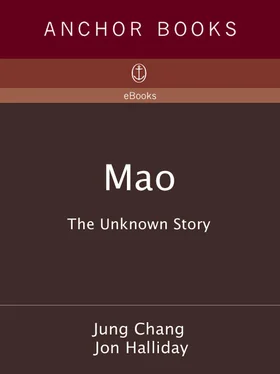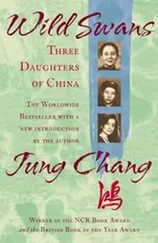But Chiang did not press on. Mao was saved by the most unlikely actor — fascist Japan.
IN 1931, Japan stepped up its encroachment on Manchuria in northeast China. Faced with threats at opposite ends of his vast country, Chiang decided on a policy of “Domestic Stability First”—sort out the Reds before tackling Japan. But Tokyo torpedoed his timing. On 18 September Chiang boarded a ship from Nanjing to Jiangxi to give a big push to his drive against Mao’s shrunken base. That very night, at 10:00 PM, Japan invaded Manchuria, in effect starting the Pacific — and Second World — War. The Nationalist commander in Manchuria, Chang Hsueh-liang, known as the Young Marshal, did not fight back. Over sixty years later, he told us why: resistance would have been futile. “There was no way we could win,” he said. “We could only fight a guerrilla war, or have a shambolic go at it … The quality of the Chinese army could not compare with the Japanese … The Japanese army was really brilliant … ‘Non-resistance’ … was the only feasible policy.”
By the time Chiang Kai-shek arrived in Jiangxi next day, 19 September, Japan had already occupied the capital of Manchuria, Shenyang (aka Mukden), and other major cities, and he had to rush back to Nanjing on the 20th to cope with the crisis. He did not declare war on Japan, reasoning, like the Young Marshal, that armed resistance would be futile, given Japan’s overwhelming military power. Chiang’s tactic was to use China’s huge space, manpower and daunting terrain to buy time, knowing that it was virtually impossible for Japan to occupy and garrison the whole of China. For now, he sought intervention from the League of Nations. His long-term plan was to modernize his army, build up the economy, and fight Japan when there was some chance of winning.
“This misfortune might even turn out to be a blessing in disguise,” Chiang wrote in his diary, “if it gets the country united.” Nanjing immediately decided to “suspend the plan of … annihilating the Communists,” and proposed a United Front against Japan. The CCP spurned the idea, saying that any suggestion that it was willing to join a United Front was “ridiculous in the extreme.” The Communists’ attitude was that the Nationalists, not the Japanese, were their chief enemy, and their slogans made this pointedly clear, ordaining “Down with the Nationalists,” but merely “Oppose Japanese imperialists.” The Party’s “central task” was described as “defending the Soviet Union with arms” (following Moscow’s line that the Japanese invasion of Manchuria was a prelude to attacking the Soviet Union).
Since then, history has been completely rewritten, and the world has come to believe that the CCP was more patriotic and keener to fight Japan than the Nationalists were — and that the CCP, not the Nationalists, was the party that proposed the United Front. All this is untrue.
When he came up with the idea of a United Front against Japan, Chiang pulled his troops out of the war zone in Jiangxi. The Reds at once exploited this opportunity to recover lost territory, expand, and establish their own state.
On 7 November 1931, the fourteenth anniversary of the Russian Revolution, this state was proclaimed. Although it was not recognized by any other country, not even its sponsor, the Soviet Union, it was the only Communist regime in the world outside the Communist bloc, which then consisted only of Russia and Mongolia.
This state was made up of several Red regions dotted around the heartland of the country, in the provinces of Jiangxi, Fujian, Hunan, Hubei, Henan, Anhui and Zhejiang. At its maximum, the total territory covered some 150,000–160,000 square km, with a population of over 10 million. At the time of its founding the largest enclave was the “Central Base Area,” the region where Mao was operating, which consisted of Red Jiangxi and Red Fujian, covering some 50,000 sq. km, with a population of 3.5 million. Moscow had designated it as the seat of the Red government over a year before, with the town of Ruijin as its capital.
Moscow also appointed Mao head of the state, with the very un-Chinese title of chairman of the Central Executive Committee. He was “prime minister” as well, being chairman of the body called the People’s Committee. On the evening the posts were announced, a crony came to see Mao. This man had personally tortured Lee Wen-lin, the Jiangxi Red leader Mao most hated, and afterwards had reported the details to Mao. He now came to offer congratulations. “Mao Zhu-xi —Chairman Mao!” he called out. “You learn really fast,” Mao replied. “You are the first person.” This torturer was the first person to use the title that was to become part of the world’s vocabulary: “Chairman Mao.”
In the outlaw land, the first Communist county chief of Ninggang was killed, in September 1928, by his fellow-Communists, seven months after he had been installed at a rally where his Nationalist predecessor was speared to death. The man Mao left in charge of the area was also killed in a bloody vendetta nine months after Mao’s departure. He had apparently had the beautiful young wife of a Party official tortured and executed on the charge of being an enemy agent. He was then killed on the same charge.
Even when the purge had counterproductive effects. A 1932 report by the (Communist) Federation of Labor said workers were “simply scared” to join Communist unions: “They have seen that the majority [ sic ] of the workers [who were] members of the trade union were executed [i.e., by their own comrades] on the charge of belonging to ‘AB.’ ”
Subsequently famous as the spy who in 1941 provided Stalin with the vital intelligence that Japan was not going to attack the Soviet Far East when Hitler invaded European Russia. One of Sorge’s assistants was a woman called Zhang Wen-qiu, whose two daughters later married Mao’s two surviving sons. She had come to Sorge’s attention through Agnes Smedley, an American agent for the Comintern.
Thanks to the control of the Red territories, Party membership rose to 120,000 in 1931, from 18,000 at the end of 1926.
9. MAO AND THE FIRST RED STATE (1931–34 AGE 37–40)
RUIJIN, THE CAPITAL of the new Red state, was situated in southeast Jiangxi, in the middle of a red-earth basin cradled by hills on three sides. It was 300 roadless km from the Nationalist-controlled provincial capital, Nanchang, but only about 40 km from the large Red-held city of Tingzhou over the border in Fujian, which was linked to the outside world by river. Semi-tropical, the area was blessed with rich agricultural products, and endowed with unusual giant trees like camphor and the banyan, whose old tough roots rose overground, while new roots cascaded from the crown.
The headquarters of the Red government lay outside the town, at the site of a large clan temple 500 years old, with a hall spacious enough to hold hundreds of people for the inevitable meetings. Where the clan altar had stood, a stage was built in the Soviet Russian fashion. On it hung red woodcut portraits of Marx and Lenin, and between them a red flag with a gold star and a hammer and sickle. A red cloth above it was stitched in gold thread with the slogan: “Proletariat of all the world, unite!” Next to it, in silver, was the slogan: “Class Struggle.” Down both sides of the hall, makeshift partitions demarcated fifteen offices as the new state administration. They had names that were direct translations from Russian, and were a mouthful in Chinese, like “People’s Commissariat for Internal Affairs.”
Behind the clan temple, a large square was cleared of trees and farmland to make room for the Communists’ staple activity: mass rallies. Later on, various monuments were built on this square. At one end was a timber-and-brick dais for holding Soviet-style military reviews. At the other was a tower to commemorate Red Army dead (called “martyrs”), shaped like a giant bullet, with numerous bullet-like stones sticking out of it. Flanking this were two memorials, one a pavilion, the other a fortress, named after two dead Red commanders. The whole set-up anticipated Tiananmen Square in Communist Peking, though the monuments were much more imaginative and colorful than the leaden architecture later to disfigure Tiananmen.
Читать дальше










